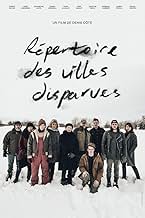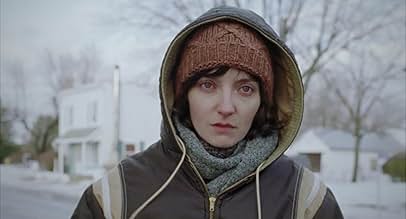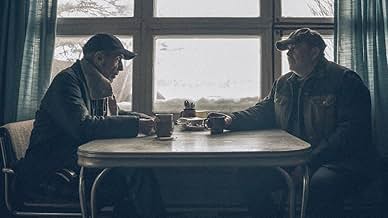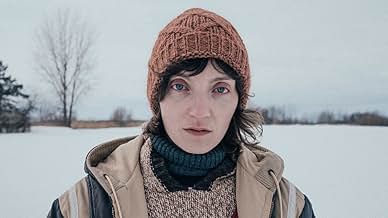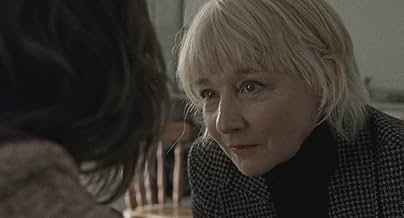VALUTAZIONE IMDb
6,3/10
1529
LA TUA VALUTAZIONE
In una isolata cittadina, Simon Dubé muore in un incidente d'auto. I cittadini sbalorditi sono riluttanti a discutere sulla tragedia. Da quel momento in poi il tempo sembra perdere ogni sign... Leggi tuttoIn una isolata cittadina, Simon Dubé muore in un incidente d'auto. I cittadini sbalorditi sono riluttanti a discutere sulla tragedia. Da quel momento in poi il tempo sembra perdere ogni significato e le giornate si allungano all'infinito.In una isolata cittadina, Simon Dubé muore in un incidente d'auto. I cittadini sbalorditi sono riluttanti a discutere sulla tragedia. Da quel momento in poi il tempo sembra perdere ogni significato e le giornate si allungano all'infinito.
- Regia
- Sceneggiatura
- Star
- Premi
- 3 vittorie e 21 candidature totali
Recensioni in evidenza
Do you believe in ghosts? Do you believe in other dimensions? Do you believe in reincarnation? Ghost Town Anthology is a film that brings questions like this to the forefront of your consciousness. The film opens with a frigidly framed car crash, that appears to happen out of nowhere, finding a way to sneak between sounds of the wind blowing and the trees creaking. The driver of the car was Simon Dube played by Phillipe Charette, leaving behind his distraught parents Romuald played endearingly by Jean-Michel Anctil and Gisele played by Josée Deschênes. His older brother Jimmy played with skill by Robert Naylor picks the film up from his brother's death, beginning a search for his brother because in his mind he could not have just left him like that even though the audience can see that Jimmy knows the true cause of his brother's death and it was not accidental, making Jimmy's search for signs of his brother all the more heart wrenching. The father, Romuald, tells his wife Giselle he is going to buy cigarettes, ultimately leaving a note explaining that he needs time and space to mourn the death of his son. Personally the scenes that followed of the father Romuald and his grieving process were some of my favorite moments of the film and the director makes no attempt at making it clear if the father is ever going to actually return.
The director of Ghost Town Anthology, Dennis Cote has quite a vision and understanding of spiritual imagery and feeling, the sound design is something that is so unique and unnervingly special. The brilliance of it is chiefly noticeable in the fathers grieving scenes. Cote masks bleak desolate moving landscapes shot as if the camera has been mounted in a 1987 pickup truck, with sounds of wind, static, and crackling; the only difference being in the patterns the sounds play in is completely different from anything I have heard before. The film was shot in 16mm and in these brief moments the 16mm film looks much closer to 8mm film, clearly having been scratched and tampered with by the creators of the film and then developed in black and white to add to the lo-fi feelings being heavily transmitted through the film. The camera movements in these very vague almost elusive scenes is all the more interesting, if it doesn't feel like it's been mounted to a pickup truck, it feels as if it's been mounted to a wounded animal walking its way to its demise, trudging along the bare landscape.
The death of the boy sends shockwaves through the small town, ultimately becoming the sole focus of the town's mayor Simone Smallwood, played by Diane Lavallée, who appears to have one sole mission in life and that is to ensure that her town carries on its daily life, every day, with no change or help from outsiders. As a reaction to the boy's death, a political official known to Smallwood sends a psychiatrist from the "big city" to assist with the psychological effects of the boy's death in the town. The new face is quickly dismissed by the mayor who claims that the towns people is made up of "grown ups" and they can "handle themselves", leaving the story to the isolation of the few faces the audience has seen. One of the faces that is most intriguing is a woman named Adele, played by Larissa Corriveau. Adele is the type of character whom simply steals the camera because she has a look that is so unusual and uncanny. Her character is a supposed newcomer to the town, making it all the more interesting due to her severe social anxiety. Dennis Cote captures how one feels when they have social anxiety with swift minimalism, particularly in a scene early on in the film where he utilizes a tracking shot. The camera tracks Adele from the washroom of a New Year's Eve party, in the middle of a pep talk nonetheless, all the way through the party until she encounters Jimmy and his best friend Andre. The way Larissa Corriveau walks through the party, making sure to never once look in place, avoiding physical contact and eye contact is beyond an accurate depiction of social anxiety and she hits her marks perfectly. The dialogue between Adele, Jimmy and Andre is innocent and naturally dry, a true contender for the most cringe worthy moment in cinema this year.
As strange people begin to arrive in the town including Jimmy having an encounter with his recently deceased brother with no explanation and more and more of the townspeople beginning to see the people themselves the film shifts its gears to more serious questions. There are multiple scenes with supremely high tension in the gradual revealing of these strange arrivals to the town. The town's people begin to almost show frustration to their attendance, not because they are ghosts but because it further punctuates their isolation by having these people show up. What more of a reason to move to the big city than having the dead walk your neighbourhood, right? This commentary of life and death, and exposure versus isolation become very focal themes in the film and it makes for truly different cinema.
Overall the film is quite good, although at times disorganized and scattered with the plot and character development. Dennis Cote has made primarily documentaries and experimental films, having Ghost Town Anthology be considered as his first official feature film. The application of 16mm film and shaky cam prove effective in not only the setting and story but mesh perfectly with Cote's eye and style. The film feels as if it is a short film that has been extended and obviously this can be attributed to Cote's former projects. It would be interesting to see him apply his eye for human nature and psychology to something slightly less experimental. In the end Ghost Town Anthology raises lots of questions about life, death, reincarnation and having enough time, and it is a quality contribution to the supernatural genre.
The director of Ghost Town Anthology, Dennis Cote has quite a vision and understanding of spiritual imagery and feeling, the sound design is something that is so unique and unnervingly special. The brilliance of it is chiefly noticeable in the fathers grieving scenes. Cote masks bleak desolate moving landscapes shot as if the camera has been mounted in a 1987 pickup truck, with sounds of wind, static, and crackling; the only difference being in the patterns the sounds play in is completely different from anything I have heard before. The film was shot in 16mm and in these brief moments the 16mm film looks much closer to 8mm film, clearly having been scratched and tampered with by the creators of the film and then developed in black and white to add to the lo-fi feelings being heavily transmitted through the film. The camera movements in these very vague almost elusive scenes is all the more interesting, if it doesn't feel like it's been mounted to a pickup truck, it feels as if it's been mounted to a wounded animal walking its way to its demise, trudging along the bare landscape.
The death of the boy sends shockwaves through the small town, ultimately becoming the sole focus of the town's mayor Simone Smallwood, played by Diane Lavallée, who appears to have one sole mission in life and that is to ensure that her town carries on its daily life, every day, with no change or help from outsiders. As a reaction to the boy's death, a political official known to Smallwood sends a psychiatrist from the "big city" to assist with the psychological effects of the boy's death in the town. The new face is quickly dismissed by the mayor who claims that the towns people is made up of "grown ups" and they can "handle themselves", leaving the story to the isolation of the few faces the audience has seen. One of the faces that is most intriguing is a woman named Adele, played by Larissa Corriveau. Adele is the type of character whom simply steals the camera because she has a look that is so unusual and uncanny. Her character is a supposed newcomer to the town, making it all the more interesting due to her severe social anxiety. Dennis Cote captures how one feels when they have social anxiety with swift minimalism, particularly in a scene early on in the film where he utilizes a tracking shot. The camera tracks Adele from the washroom of a New Year's Eve party, in the middle of a pep talk nonetheless, all the way through the party until she encounters Jimmy and his best friend Andre. The way Larissa Corriveau walks through the party, making sure to never once look in place, avoiding physical contact and eye contact is beyond an accurate depiction of social anxiety and she hits her marks perfectly. The dialogue between Adele, Jimmy and Andre is innocent and naturally dry, a true contender for the most cringe worthy moment in cinema this year.
As strange people begin to arrive in the town including Jimmy having an encounter with his recently deceased brother with no explanation and more and more of the townspeople beginning to see the people themselves the film shifts its gears to more serious questions. There are multiple scenes with supremely high tension in the gradual revealing of these strange arrivals to the town. The town's people begin to almost show frustration to their attendance, not because they are ghosts but because it further punctuates their isolation by having these people show up. What more of a reason to move to the big city than having the dead walk your neighbourhood, right? This commentary of life and death, and exposure versus isolation become very focal themes in the film and it makes for truly different cinema.
Overall the film is quite good, although at times disorganized and scattered with the plot and character development. Dennis Cote has made primarily documentaries and experimental films, having Ghost Town Anthology be considered as his first official feature film. The application of 16mm film and shaky cam prove effective in not only the setting and story but mesh perfectly with Cote's eye and style. The film feels as if it is a short film that has been extended and obviously this can be attributed to Cote's former projects. It would be interesting to see him apply his eye for human nature and psychology to something slightly less experimental. In the end Ghost Town Anthology raises lots of questions about life, death, reincarnation and having enough time, and it is a quality contribution to the supernatural genre.
Ghost Town Anthology is a weird genreless French film where a town of just 215 dwellers somewhere near Quebec in interior Canada are haunted by living ghosts after an unfortunate accident that no one knows how happened. It is more about the idiosyncratic characters in the film that you get if you manage to endure the 90 minutes of confusing plot where the optimistic mayor is not afraid of whatever the village is about to experience and majority of the citizens are scrambling to find answers. From where or who they don't know. Much like what or why that I don't know or didn't get about Ghost Town Anthology, a film where I only dug the fine, haunting score. TN.
(Watched and reviewed at its India premiere at the 21st MAMI Mumbai Film Festival.)
(Watched and reviewed at its India premiere at the 21st MAMI Mumbai Film Festival.)
Cold, mind numbing and one of a kind horror. A movie that walks over various abstractions and gives you genre moments that hit you distinctively. We are way too used to being fed with jump scares in an unwritten contract sort of a way. This is one of those movies that does it differently. I could call it an abstract fantasy-horror.
Definitely an acquired taste so I'd highly recommend you to watch it and decide for yourself.
Pros:
1. The colour palette of grey, white, black, and brown helps to cement a bleak and oppressive atmosphere.
2. Robert Taylor (Jimmy Dubé), Josée Deschênes (Gisèle Dubé), Larissa Corriveau (Adèle), and Diane Lavallée (Simone Smallwood) give great performances.
3. The score brilliantly enshrines the movie in an eerily disturbing tone.
4. For the most part, the film keeps the spirit of Simon Dubé (Philippe Charrette), as well as the other spirits, out of the view of the audience. This builds up the mystery and intrigue masterfully.
5. The sound design is crisp and clear, and it highlights, and really brings forth, the theme of loneliness excellently, by emphasising just how remote the town is.
Cons: 1. There are a few plot-holes. For example, it's never explained why Adèle just starts floating mid-air. In addition, when the towns-people find out the dead are watching them, they react (mostly) as if it's normal. 2. The camera tends to jerk and shake an obscene amount of times. Surely they could have found a way to steady the camera via a tripod, or something along those lines. 3. At times, the pacing is far too slow therefore becoming a bit of a chore to get through. 4. The paranormal sub-plot and the overcoming of Simon Dubé's death plot don't mix well at all. They feel like two separate story-lines jostling for attention. In fact, the paranormal part ends up overshadowing the latter in regards to both, entertainment and memorability.
Cons: 1. There are a few plot-holes. For example, it's never explained why Adèle just starts floating mid-air. In addition, when the towns-people find out the dead are watching them, they react (mostly) as if it's normal. 2. The camera tends to jerk and shake an obscene amount of times. Surely they could have found a way to steady the camera via a tripod, or something along those lines. 3. At times, the pacing is far too slow therefore becoming a bit of a chore to get through. 4. The paranormal sub-plot and the overcoming of Simon Dubé's death plot don't mix well at all. They feel like two separate story-lines jostling for attention. In fact, the paranormal part ends up overshadowing the latter in regards to both, entertainment and memorability.
I think somebody forgot to create a conflict or subject in the plot.. i didnt enjoy except baloon girl... MUBI keep the money but give my precious time back that i lost for this movie at least 40 percent of it
Lo sapevi?
- QuizAdèle is the only character to wear colorful clothing.
- BlooperDuring the levitation scenes, the 'altitude' of Adèle in the sky changes from scene to scene.
- ConnessioniFeatured in 2020 Canadian Screen Awards for Cinematic Arts (2020)
I più visti
Accedi per valutare e creare un elenco di titoli salvati per ottenere consigli personalizzati
Dettagli
- Data di uscita
- Paese di origine
- Lingua
- Celebre anche come
- Ghost Town Anthology
- Luoghi delle riprese
- Saint-Michel, Québec, Canada(interior and exterior locations)
- Azienda produttrice
- Vedi altri crediti dell’azienda su IMDbPro
- Tempo di esecuzione1 ora 37 minuti
- Colore
- Proporzioni
- 1.85 : 1
Contribuisci a questa pagina
Suggerisci una modifica o aggiungi i contenuti mancanti

